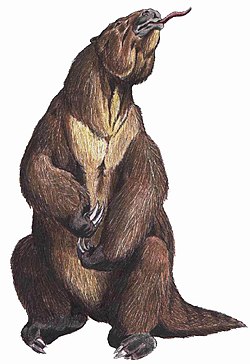Australonyx
| Australonyx Temporal range: Late Pleistocene (Lujanian) | |
|---|---|
 | |
| Skull | |
| Scientific classification | |
| Domain: | Eukaryota |
| Kingdom: | Animalia |
| Phylum: | Chordata |
| Class: | Mammalia |
| Order: | Pilosa |
| Family: | †Megalonychidae |
| Genus: | †Australonyx De Iuliis et al, 2009 |
| Species: | †A. aquae |
| Binomial name | |
| †Australonyx aquae De Iuliis et al, 2009 | |
Australonyx is an extinct genus of ground sloths, endemic to South America during the Late Pleistocene. It was found in Brazil.[1]
Discovery
[edit]The holotype specimen was recovered from Poço Azul, an underwater cave system in Nova Redenção, Bahia state. (The same cave also yielded remains of another extinct sloth species, Ahytherium.) The specimen was well preserved, consisting of both the front and back half of the skull (but missing the midsection), the mandible, most of the spine, and some elements from the limbs.[2] Additionally, a nearly identical almost complete skull from Rondônia can be referred to this species.[3]
Ecology
[edit]Australonyx is suggested to have been a mixed feeder (both browsing and grazing).[4]
References
[edit]- ^ "Australonyx in the Paleobiology Database". Fossilworks. Retrieved 17 December 2021.
- ^ De Iuliis, Gerardo; Pujos, François; Cartelle, Cástor (December 2009). "A new ground sloth (Mammalia: Xenarthra) from the Quaternary of Brazil". Comptes Rendus Palevol. 8 (8): 705–715. Bibcode:2009CRPal...8..705D. doi:10.1016/j.crpv.2009.07.003.
- ^ De Iuliis, Gerardo; Cartelle, Cástor; Pujos, François (May 2016). "New Pleistocene remains of megalonychid ground sloths (Xenarthra: Pilosa) from the intertropical Brazilian region". Journal of Paleontology. 90 (3): 578–587. Bibcode:2016JPal...90..578D. doi:10.1017/jpa.2016.52. hdl:11336/59437. S2CID 89535019.
- ^ Dantas, Mário A.T.; Santos, Adaiana M.A. (August 2022). "Inferring the paleoecology of the Late Pleistocene giant ground sloths from the Brazilian Intertropical Region". Journal of South American Earth Sciences. 117: 103899. Bibcode:2022JSAES.11703899D. doi:10.1016/j.jsames.2022.103899.


 French
French Deutsch
Deutsch

